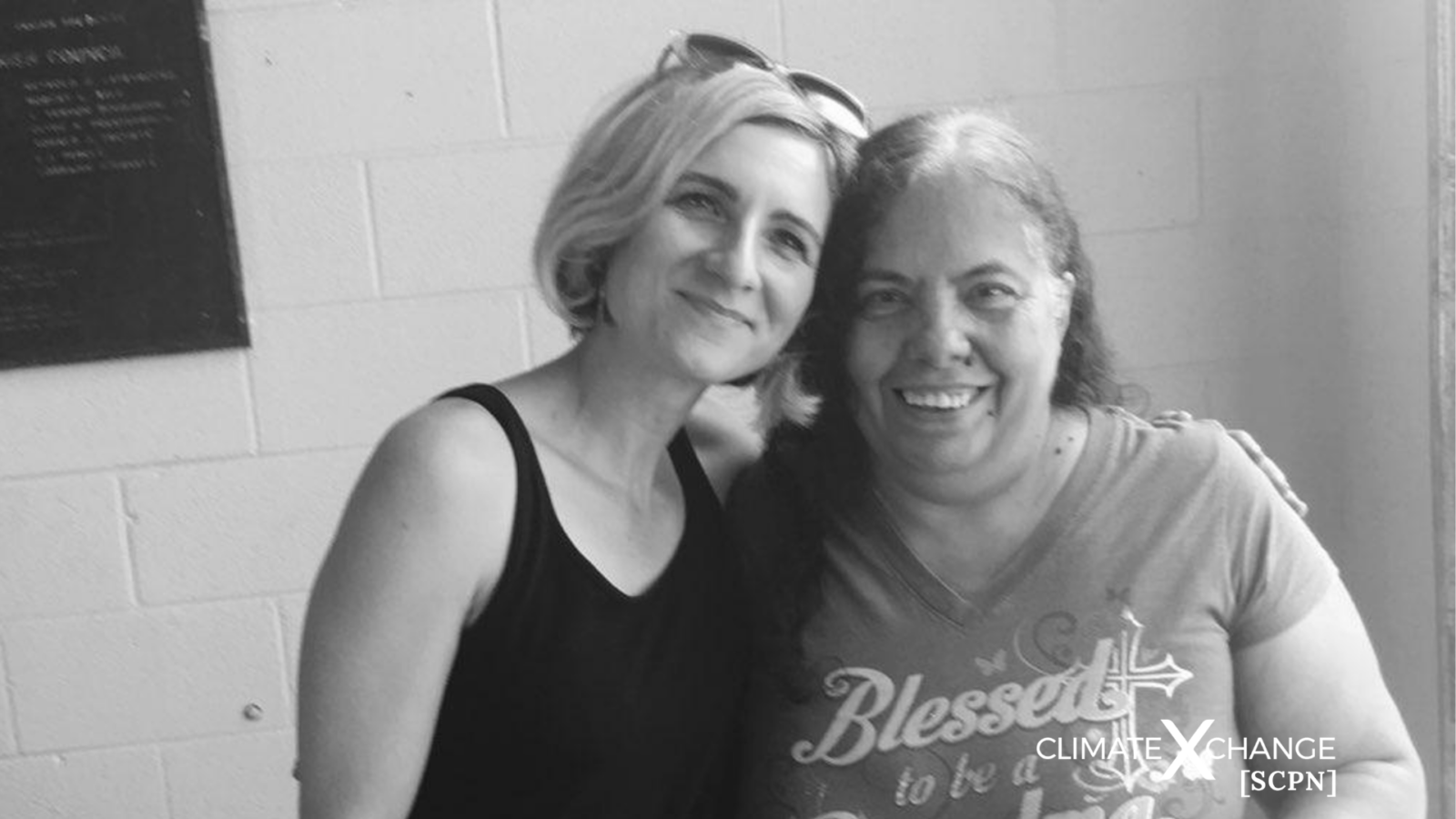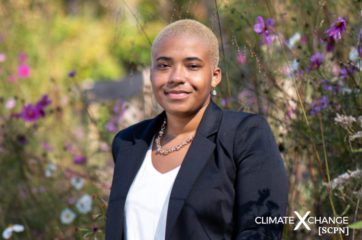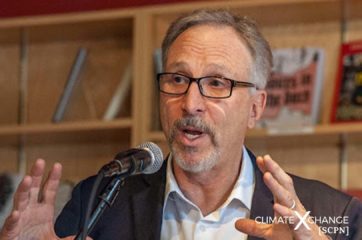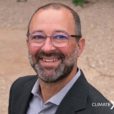All across the country, members of our State Climate Policy Network (SCPN) are fighting to make an impact on climate change in their communities. We have individuals in our Network from all 50 states, each experiencing climate change differently in their local areas and finding unique solutions to build resiliency efforts.
Dr. Jessica Simms is a former Resilience Policy Analyst for the State of Louisiana’s Office of Community Development (OCD). Her work with OCD focused on equity-based planning as the lead outreach and engagement coordinator for the Resettlement of Isle de Jean Charles. Island residents, which are largely a Native American community, will soon relocate from their ancestral lands due to lack of hurricane protection, flooding, and impending sea-level rise. Dr. Simms built relationships with Islanders and sought to learn more about the decision-making processes residents were undergoing, and in turn, enhanced her ability to understand the justice aspect of relocation. Dr. Simms has a Ph.D. in Geography from Louisiana State University (LSU) and a Master’s in Geography from San Diego State University.
Note: This interview was conducted in early August 2021 before the impacts of Hurricane Ida devastated communities in Louisiana, and had particularly severe impacts on the community of Isle de Jean Charles.
Learn more about how you can help Islanders as they recover from Hurricane Ida.
This interview has been lightly edited for clarity and brevity.
Nicole Howard: Hello! I have been researching climate migration and I’m excited to hear about this project. Please tell us a little bit about who you are and your career path.
Dr. Simms: Thank you! The state of Louisiana has a very ambitious $50 billion coastal master plan. I started doing research with that plan as the basis about ten years ago in Terrebonne Parish. My research began with going to public community meetings and starting to ask folks what they and their families were thinking about land loss, wetland restoration, the politics of wetland restoration, and what they were thinking would happen if they had to move. Terrebonne Parish has the highest rate of land loss of any parish in Louisiana, it’s a really large Parish. That’s where Isle de Jean Charles is.
My Ph.D. advisor at LSU, Craig Colten, is a cultural geographer. He had grant money from the Substance Abuse and Mental Health Services under the U.S. Department of Health and Human Services to conduct interviews with Gulf Coast residents on resilient practices. For example, a resilient practice one elderly woman I interviewed had perfected for her hurricane prep was to number the boards she’d put up on her windows to fit each specific corresponding windowsill. This was how she knew where each board went and could quickly cover her windows when prepping for a hurricane. I was looking at the ways people adapt to stay in place and how that interacts with folks’ mental health.
In my work as a geographer in Louisiana, I began to talk to people more and more about migration. Are they thinking about it? Are they talking about it? Are they saying, ‘I’m more resilient because I’m gonna stay in place,’ or do they say, ‘I’m resilient because I’ve moved to a parish that is less likely to get flooded, or less likely to get hit by a hurricane?’
I’m not living on the frontlines myself. I can’t imagine what the residents of Isle de Jean Charles felt when they had to evacuate seven different times last year. It’s expensive. It’s exhausting. And it wasn’t until the seventh evacuation that a hurricane actually did any damage to the island. At that point, there were a couple of people that said, ‘We’ve already left six times, it’s gonna be fine.’ It wasn’t. A roof partially flew off someone’s house and the residents were inside trying to stay safe in a bathtub. It was terrifying for them.
Nicole Howard: I heard you talk about your geography background but your studies also focused on anthropology and climate migration research. Can you tell me how that prepared you for your work in this program?
Dr. Simms: Anthropology, broadly, is the study of what makes us human. Geography is the study of places and the relationships between people and their environments. They are similar in that they are seeking to understand human behavior and sociocultural systems. I wanted to know how people relate to the land and how, in turn, they relate to each other. And, how and where does culture come in, and how do those all intersect and inform each other? I want to hear people’s stories about how they got where they are now. We live in the same state, but their frame of reference is really different from mine.
When I was sitting in their living rooms, I realized that I would have to do a lot of translating between the state’s policies and practices and residents’ needs and understandings. I would have to think carefully about how I interacted with folks — how it is that I come to someone’s door? How is it that I take notes or don’t take notes? How is it that I build relationships with residents?
Nicole Howard: As we know, community relocation is considered a last resort. What were the other options that were considered for the residents?
Dr. Simms: Relocation is a last resort often because there are people that don’t ever want to move. There are older folks who have been living in the same house from their childhood and the same house from their parents’ childhood. ‘What is the point of moving to a brand new house, if it’s not home?’ some asked.
The parish decommissioned gas on the island around the time of Hurricane Isaac in 2012 and told the residents that they weren’t going to fix the two-mile road to the island anymore. Water regularly comes up on the road and then folks get stuck, school buses can’t pass, and residents can’t get to work or receive medical attention. In this state-run program, residents can choose to remain on the Island, they can move with the majority of Islanders to new homes about 40 miles inland, or they can receive financial assistance towards a new home apart from the community, but out of the Special Flood Hazard Area. The state just released a Phase Two Planning Report.
Nicole Howard: Are there other services and amenities on the island currently, or is it just residential?
Dr. Simms: About half the island is fishing camps and there are still amenities including a marina and utilities (water and electricity). There are still about 30 residential homes. But, there are always rumors that the parish is going to decommission other utilities next.
Nicole Howard: Are there residents who are still planning on staying on the island? If the road isn’t repaired and utilities are decommissioned, will they be completely cut off?
Dr. Simms: So, that’s an intriguing situation currently. In the last year, the State Department of Wildlife and Fisheries put in five new piers with parking spaces and renovated the boat launch along Island Road. Across from the piers, the parish is building up a boulder and rock wall that is eight feet high to prevent the water from coming up onto the road. It’s causing some alarm bells to go off. The residents have been saying all along, ‘Once we leave, this is going to turn into luxury camp land.’ The timing on all of this road improvement is really interesting considering that it’s all coming on the heels of residents committing to move off the Island.
Nicole Howard: Climate XChange has a particular interest in equity and environmental justice. Beyond what we’ve already talked about, did you have any other main concerns for this community? Were you able to address those as your scope of work was limited by the state?
Dr. Simms: Yes. Throughout this work, I often found that all sorts of people, including some I worked with, would be saying, ‘Look, I don’t understand why people are pushing against us because we’re giving them a new house.’ I frequently had to explain that it is not just about this new big, beautiful house. People have memories in their house; they want to be in the same house where their great grandparents built their lives, their gardens, their livelihoods, their families, and their identities. One resident said to me, ‘The island is how I know who I am.’ I often had to explain that just giving someone a new house doesn’t necessarily mean that they’re going to jump at the opportunity and give up what they have and what they know best. The residents did not want to give up their land and homes in order to receive a new one. They were clear in that conviction if they were going to participate in the project. After more than a year of negotiating, the state agreed that if the residents participate in this program, they can keep their island house but cannot live in it permanently or make repairs exceeding $2,500.
Nicole Howard: Did the island residents have roles in other planning and decision-making processes related to choosing a new location or the way the community would be developed?
Dr. Simms: Most folks have lived in Terrebonne Parish all their lives; their families are in the parish, and they have a strong connection to the land there. The neighboring parish is as far as most Islanders want to go, but they ultimately want to stay in the same parish. The state vetted about 20 properties using a criteria matrix to compare how often it floods, the elevation, size, price, etc., and came up with five configurations of three different sites. We took residents on a site tour, talked to the landowners, asked questions, and walked the land. A majority of residents chose the property they will move to. There was also a steering committee during the planning phase that included five island residents, one parish representative, the Director of Indian Affairs for the governor’s office, and two women from each of the tribes that Island residents identify with. The state also had design workshops and discussions about how the new site would be configured, house design — porches, roof materials, elevation, indoor/outdoor spaces, etc. However, the level of participation and inclusion in the process, as well as the capacity-building in this community and on this project could stand to be improved. The residents certainly could have had more input than they were permitted. That would have made things go smoother.
Nicole Howard: What were some of the things that residents were specifically looking for in the land when you went on the tour? What were some of the things that were most important to them?
Dr. Simms: Whether or not it would flood, privacy and seclusion, and the size of their lots. They wanted space comparable to what they had on the island. They also wanted some type of water feature, and there are two on this new property — Bayou Blue and Bayou St. Louis. And there are 90 acres of wooded wetlands that won’t be won’t ever be developed.
Nicole Howard: It was important to find a property that allowed the community to continue culturally significant activities. Based on my research, it seems the new location is close to other developed areas. Other than building the neighborhood infrastructure and the amenities, are residents expected to integrate into the broader community for services, like doctors and shopping?
Dr. Simms: Most people go to the doctor and store in Houma already, which is half an hour from the island and 20 minutes from the new site. They’ll be living in a more highly administered, more regularly patrolled, and controlled area – it’s not for everyone. In terms of integrating with their neighbors, there are three subdivisions that are around the new site. I’m really not sure how folks will integrate.
Nicole Howard: If the residents choose not to move to the new location, will the government subsidize their move elsewhere?
Dr. Simms: Yes, there’s one family who has chosen to do that. Based on their family size they get a certain amount of money to buy a home outside of the Special Flood Hazard Area.
Nicole Howard: The entire island will eventually be underwater and that is the ancestral land. Are there burial sites on that land?
Dr. Simms: We had a lot of discussions with the residents. No one told us that they wanted to relocate the remains. When we had the steering committee meetings, we asked folks about that and what they wanted to do about the cemetery. Whether they wanted to exhume the remains, put them in the new community, and essentially relocate their cemetery. They were not interested in moving the cemetery. I also spoke to the state archeologist who said he couldn’t imagine a more complicated project. There are a lot of unknowns — how many burials, the water table level, what actually remains there.
Nicole Howard: To date, this is the only U.S. relocation project that has been fully funded. Would this relocation have been possible without the grant award?
Dr. Simms: Interesting question, no one’s ever asked me that before. There were a couple of previous attempts to resettle folks. The first was the Army Corps of Engineers, who did a cost-benefit analysis and determined the levee protection system was too expensive to include Isle de Jean Charles. They offered residents money to relocate. Terrebonne Parish also put up money to relocate residents a couple of years later. But, both required 100% participation. I don’t think that this relocation would have been possible without the grant award. Community relocations are not cheap. And outreach, collaborating on design; just regular, consistent communication between administering, receiving, and moving parties — this is not often emphasized in these types of projects. But, in this case, the outreach was key. There’s an incredible amount of distrust for the government here. In some people’s eyes, it’s just this monolithic entity that is working to make our lives as Louisianans living on the coast harder. I really don’t think this would have been possible if I hadn’t gone down to the island nearly every Friday and had frank and empathic conversations with people. I was really candid with folks and as transparent as I possibly could be. Some people started to trust the process.
Nicole Howard: Do you know if the state of Louisiana has plans to relocate other communities and if they have dedicated funding for those projects?
Dr. Simms: Currently, there’s another community, Pecan Acres, that is in Pointe Coupee Parish. The homes there flooded 17–18 times in the last 30 years and residents call it “Flood City.” The neighborhood was built in the 60s and 70s on an old dumpsite on low-lying swampland. The state is resettling all of those folks, mostly together, into new homes in a subdivision.
Nicole Howard: Do you know about the funding of that resettlement?
Dr. Simms: The funding came from a couple of places – state and federal grants, including from the U.S. Department of Natural Resources Conservation Service (NRCS).
Nicole Howard: What is something that you’ve learned from the relocation project that you will carry with you?
Dr. Simms: Place attachment, or the psychological, symbolic, and cultural significance that a community assigns to land, is an extraordinary challenge for resettlements. The intangible connection to an area of land — feelings of belonging, lifestyle, family connections, and culture — can tether people to their land. One resident will tell you that the only way anyone is going to get him to leave is in a box. And that should be his choice. Moving away from your place and not having the ability to go back, especially, is a traumatic process. Folks are grieving these losses. But, the losses can be lessened if the relocation is a community-driven, community-designed process with those who will be moving involved at every step of the way.
And finally, I have built relationships with people that I love and cherish. We will continue to be in each other’s lives. When I had to tell people I was leaving, a lot of folks wanted to know if I’d still be coming to the island. I said, ‘You’re still my family.’









